Imagination Launches New Low Power Wireless IP: Ensigma Whisper
by Stephen Barrett on April 15, 2015 10:00 AM EST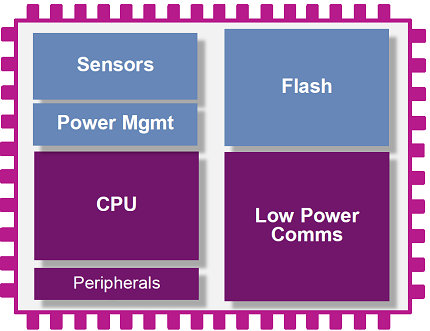
Today Imagination is launching a new set of licensable wireless intellectual property (IP) called 'Ensigma Whisper' to complement its portfolio of other SoC IPs. This announcement gives Imagination a more complete portfolio of large SoC IP blocks and notably differentiates Imagination from ARM who does not have a comparable wireless IP offering. Imagination claims the patented power optimizations makes Whisper the highest efficiency wireless IP available.
Customers licensing Ensigma Whisper receive access to Imagination's 'Radio Processing Unit' or RPU. This RPU is a complete set of IP from antenna to software, including all parts in between such as RF transceivers and baseband processing.
Imagination considers the Ensigma Whisper brand to be a collection of different wireless IPs, and is launching three models today. The C5300 is a Bluetooth LE (Low Energy) solution, C5400 is Wi-Fi 802.11n 1x1 and the C5401 is a combination model featuring both with separate paths enabling simultaneous operation. Here's a gallery of the Imagination overview slides for each model.
Imagination plans to fill out the Whisper line with more protocols such as LTE CAT 0/1, 802.15.4 and 802.11ah. This will provide more mobility as well as mesh networking capabilities.
Imagination actually already had wireless IP in their portfolio via the high power Ensigma Explorer series, but to meet the stringent size, cost, and power requirements of SoCs targeted to IoT and wearable applications Enigma Whisper was a redesign from the ground up. During the press briefing we were given an opportunity to ask questions and this avenue yielded some interesting details.
While most of us know that devices tend to sleep more than they are awake, Chakra Parvathaneni, vice president of the Ensigma business operations at Imagination, provided some numbers sourced by profiling a variety of IoT and wearable devices. Chakra stated that for every 300ms of time, a typical IoT device is only awake 4ms. Furthermore, when a device is connected to a populated WiFi network, only 1 out of every 100 times RX packets are processed is there also TX activity. As a result Imagination focused its optimization efforts on sleep power and RX efficiency.
One of these optimizations is a patented technique called early packet abortion, which works in tandem with rapid sync convergence. Imagination's internal data showed that on a populated Wi-Fi network a huge number of packets being synchronized to and decoded by a given device are actually for other devices. These are normally discarded but only after significant signal processing (and thus power). To prevent this waste, after decoding a packet actually intended for itself, Whisper saves metadata about the synchronization and decoding operations performed. In continued operation, as long as the connected access point does not change, Whisper uses this meta data to take short cuts in synchronizing and decoding future packets. This improves efficiency for self-addressed packets and allows early abortion of packets intended for other devices.
Other optimizations discussed by Chakra are that the Ensigma Whisper baseband was optimized to operate at 20 or 40 MHz frequencies (depending on wireless channel width) and use an 8-bit data path. Chakra mentioned this is a significant improvement over traditional designs that operate at 80 MHz and use a 10-bit data path.
The Imagination supplied data shown above gives the benefits of these optimizations. While we cannot do independent verification of this data yet, it is great to see continuous development in wireless power efficiency.
Finally, Imagination states that the embedded microcontroller of the Ensigma Whisper can be loaded with custom firmware to provide protocol layer 2 processing and even application level logic, eliminating the need for a paired general purpose CPU. If a general purpose CPU is needed, Imagination would love to sell you its MIPS CPUs, but stated Ensigma Whisper is compatible with almost any CPU type (including ARM).
On the software side, Imagination offers connectivity of devices to internet servers via their Flow Cloud stack. Flow Cloud provides features such as device and user management, data logging, event handling, asynchronous messaging, e-payments, and even internet radio.
Ensigma Whisper is available now for licensing, so we should see devices containing it later this year.
Source: Imagination Technologies


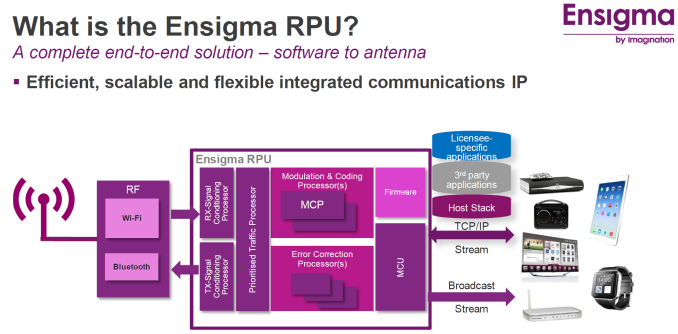



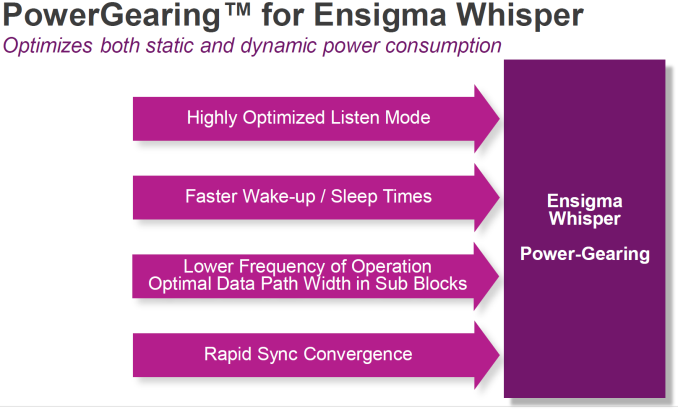
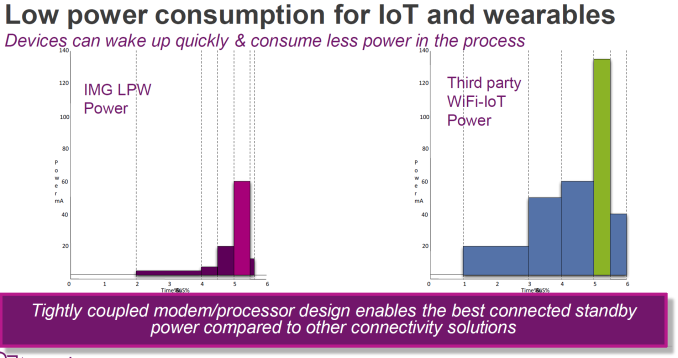
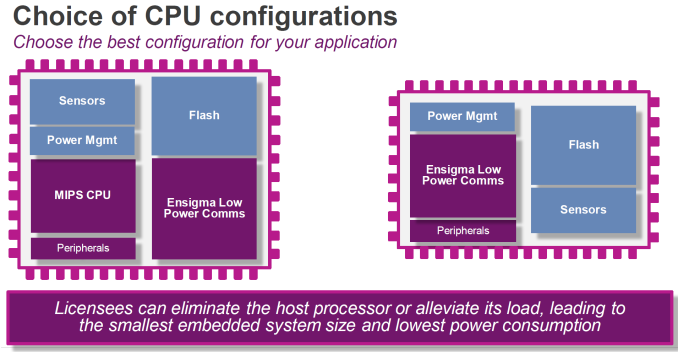
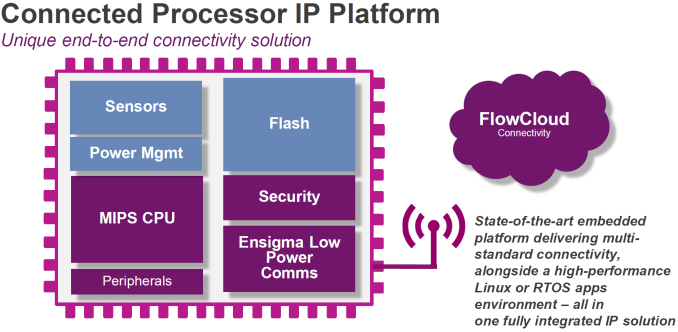








9 Comments
View All Comments
Scabies - Wednesday, April 15, 2015 - link
Oh hey, another IoT namedrop and still no things.name99 - Wednesday, April 15, 2015 - link
Imagination's market cap is around $550M. Apple has paid around this much in the past for previous technology acquisitions like PA Semi or Anobit, not to mention the $3B they paid for Beats.Point is, I wonder how long till such an acquisition happens. It seems to fill holes in Apple's vertical integration that make sense --- both GPUs and now RF. Hell, even having the MIPS license in their back pocket is useful insurance on the off-chance that they might have a problematic disagreement with ARM.
tehkirby - Thursday, April 16, 2015 - link
Intel also has a large share in imagination. If Apple wanted to buy it they need to pay a substantial premium to current market cap. Intel goes back and forth between using their own GPUs and Imaginagion's GPU in their mobile chips.tehkirby - Thursday, April 16, 2015 - link
Actually, looks like Intel sold out in February. Maybe Apple can pick it up, but if Intel doesn't want them, I don't know if Apple will.Penti - Thursday, April 16, 2015 - link
Not sure what Apple would want with MIPS Technologies and other stuff Imagination has it's hands in, Apple obviously benefits from Imaginations use in competing devices when it comes to GPU as it means development, and standardization work that also benefits Apple in the end. Intrinsity which did work closely with Samsung in Texas is also one of their most important buys in the semi/SoC space though it didn't cost that much. Also Imgtec is a UK-based firm which could have some trouble folding into Apple. They could just as well start to design RF-frontends and modems too. But Apple isn't a conglomerate that wants to do it all, cpu arch and software is really where they're at. Using large Imgtec implementations is still competitive for them. Others even assemble stuff in relatively high wage countries and do everything from chemicals to semiconductors and electronics, Apple can save their money on their pile (or pay to share holders) because they are not investing in manufacturing facilities and so forth, Taiwan basically goes bust financing the Taiwanese-owned ODM's though.name99 - Thursday, April 16, 2015 - link
What it gets Apple is a set of engineers with proven GPU and RF deign skills.Why would Apple want these? For the same reason they designed their own CPUs --- they can enforce their priorities rather than having to wait for the market as a whole to match those priorities.
With GPUs those priorities probably include both performance and much tighter integration with the CPU (ie the HSA vision, only far more aggressive). With RF those priorities probably include not so much high end performance as lower power; for example if they were to design a proprietary protocol between aWatch and iPhone which exactly matched their needs and used half the power of BT LE (because it was only solving ONE problem, not a variety of problems), that would be of substantial value to them.
cf their purchase of Anobit which seems to have culminated now in Apple SSD controllers not just in iOS devices but also in MacBooks.
Penti - Thursday, April 16, 2015 - link
Qualcomm was the leader in LTE implementations, others doing modems where just playing catch-up. You avoid such situations when you don't design these things yourself. Really the reason they went Intel and ARM to begin with. They weren't interested when Broadcom's LTE modem business folded or when ST-E's mostly did. Their WiFi/BT-tech mostly comes from Broadcom and Murata.iOS devices uses Hynix, Toshiba, Sandisk and Samsung eMMC NAND with the respective companies controllers/firmware. Only one Macbook appears to have a custom controller.
Apple might be interested in low power RF tech, but not geared for the markets that the announcement here does. For now iOS devices and Apple Watch uses Broadcom's WIFI/BT solutions. ImgTec for them is obviously about GPU's.
Tangey - Thursday, April 16, 2015 - link
Isn't LTE capability the reserve of a very select few in the industry? As I recall many in the industry stated they "had" LTE capability, but very few got it all the way to implementation and passed the various conformancy and certification processes.So IMG looking to have "LTE" as a licensable IP assets to others looks highly ambitious to say the least.
Penti - Thursday, April 16, 2015 - link
This is CAT 0/1 for embedded devices, M2M/IoT.